“Setting goals is the first step in turning the invisible into the visible.”– Tony Robbins
Humans are obsessed with goals. It speaks to a raison d’etre; something deep inside the human spirit preoccupied with a sense of progress and ambition. For almost a decade I’ve worked towards goals and objectives in various roles throughout my career in technology disciplined by the results-driven time-bound operating model of Silicon Valley startups. However, it is only in recent years that I started to proactively apply the same frameworks and principles to my personal life as I’ve entered into my 30’s and with demonstrable results.
What am I solving for?
In a previous life I was compulsively and exclusively career-oriented to a fault where I deprioritized work-life balance and tied up so much of my personal identity in my career; accolades I earned, lofty titles I was promoted into, keynote conferences I spoke at which over time created a false sense of self borne out of an artificial environment. I willingly worked late nights and weekends to achieve all of this perpetuating that identity for years but later questioned at what cost and why.
On reflection, it was an invaluable journey that gifted me many skills and continues to compound for me even today but I am disappointed with how I managed it sacrificing balance and coming close to burn-out. Nonetheless, it was an intimately valuable lesson for me on work-life balance, purpose, and identity which I’ve now come to appreciate in bringing a whole sense of self to my career and personal life.
Perhaps I’ve manifested some sort of confirmation bias or feel I’ve unlocked a placebo effect around personal goal setting, but call it what you will it has created positivity, momentum and a desire to build a more well-rounded individual. In my day job, I am fond of the old adage ‘what gets measured gets managed’. In applying this to personal growth; it is this very sentiment that has helped me to create a more holistic approach to life progress and learn from my successes and failures.
In the same vein as mankind’s obsession with progress so too are we obsessed with years as a unit of measurement. So it is only natural at the end of each year to reflect and introspect on life which I’ve been doing in a more organized and formal way in recent years. I analyze where I have been successful and what I have gained from learnings experienced through the lens of failure. Since I’ve entered my 30’s I conduct what I call a ‘life review’ in January of each year to keep myself honest across a few dimensions which I’ve realized are key to maintaining my energy and focus in life and in work.
Self-actualization
- Am I doing what I love and taking tangible steps towards what I view as a self-actualized future version of myself?
Personal challenge
- Am I challenging myself and learning new things in service of the future version of myself?
Life balance
- Do I have balance in my being across career and personal life?
To this effect, I’ve implemented a simple framework that ensures I do not deviate from what is important to me and optimize for making decisions that my future self will thank me for in a decade to come. There are three pillars that I use to inform my approach; these pillars are supported by the Japanese concept of IKIGAI which I have found to be a useful tool in guiding my decision making based on what makes me unique as an individual. As a complete exercise, this typically takes me 90 minutes to complete and is a high-ROI activity for me in planning.
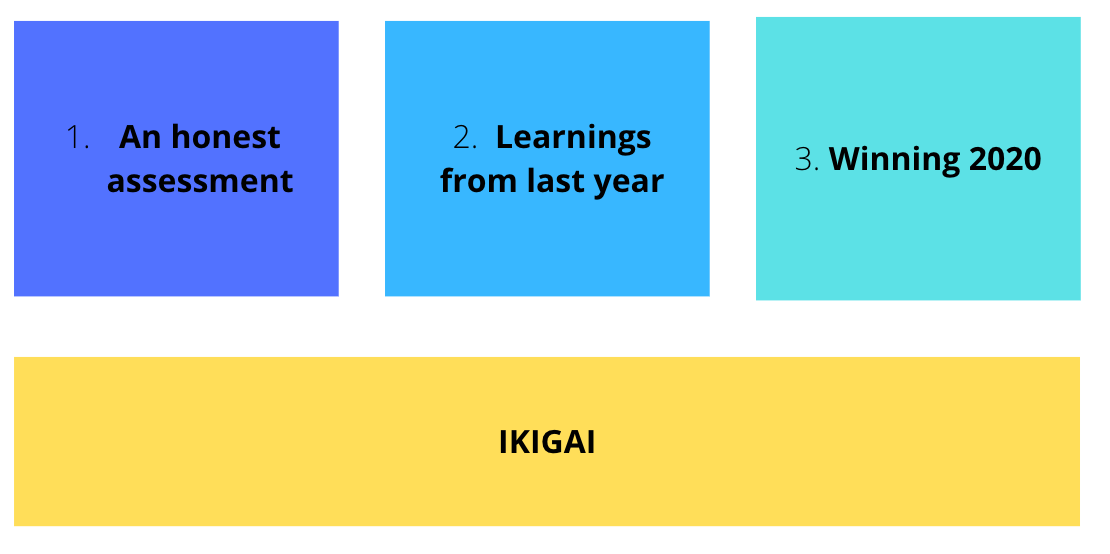
- An honest assessment of where you are
- What were your learnings from last year?
- How will you win 2020?
1. IKIGAI - Are you doing what you were put on earth to do?
'Your time is limited, so don't waste it living someone else's life. Don't be trapped by dogma - which is living with the results of other people's thinking. Don't let the noise of others' opinions drown out your own inner voice. And most important, have the courage to follow your heart and intuition'.- Steve Jobs
Many years ago I landed upon the concept of IKIGAI in searching for a framework to explain career motivation and life purpose to some of my direct reports at Twitter. IKIGAI is a Japanese concept which roughly translates to ‘the reason for which you get up in the morning’.As a task-oriented career-type my default tendency was to think only in progress, reward, and prestige but ultimately accolades and incentives in isolation are short-lived without balance, a bigger vision, and purpose in your life. In this context the reason IKIGAI is such a powerful tool is that it serves as a forcing-function for a more holistic approach to self-development and growth identifying the intersection of your key motivators across your own lived experience that are unique to you and I as individuals :
- What you love
- What you care about
- What the world needs
- What you can get paid for
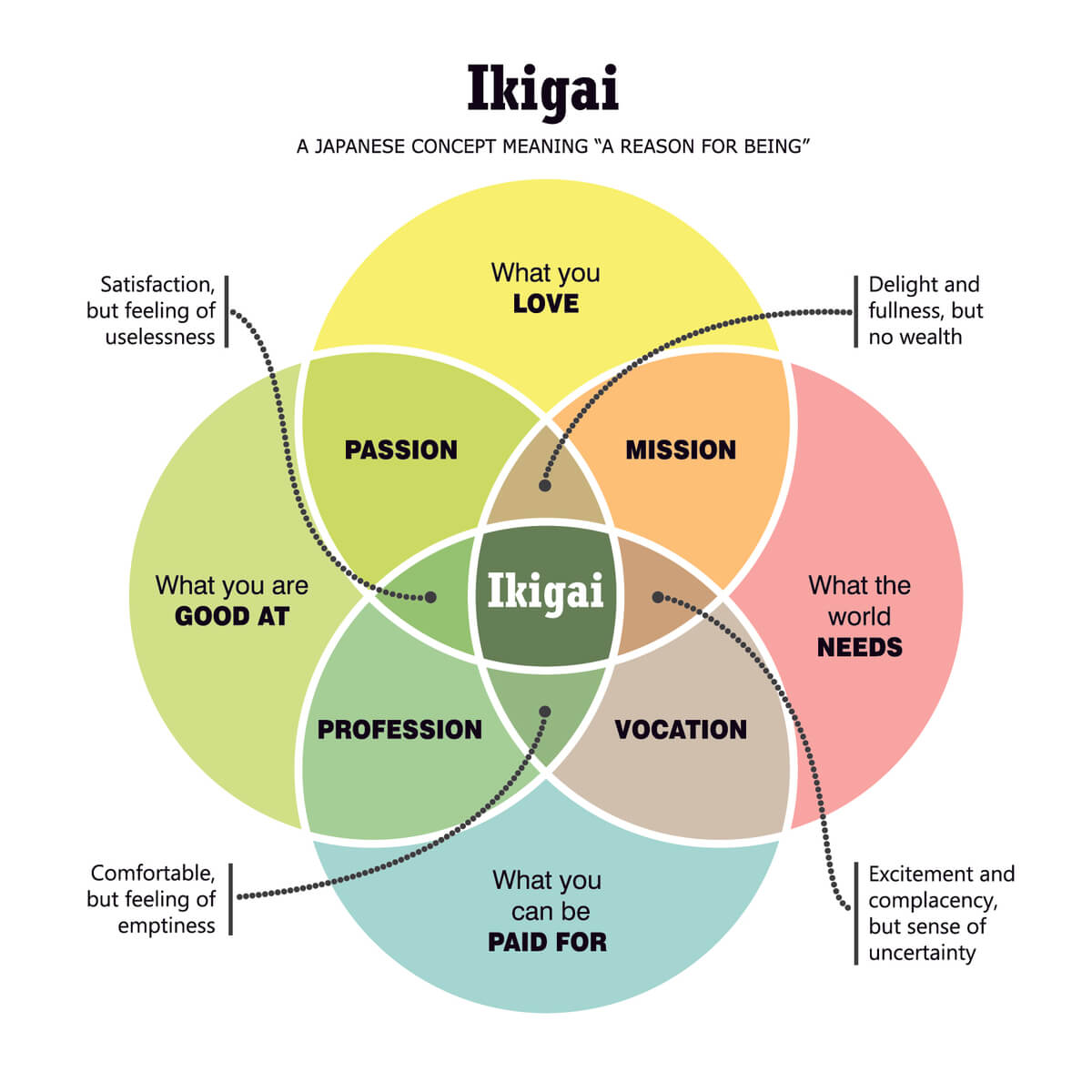
The key to success with IKIGAI is ensuring that you do not simply interpret it as pursuing your passion but more deeply identify environments where you have been most successful and energized as an individual. IKIGAI dictates mastery, autonomy and purpose should be present in your path. Moreover this should be a conscious choice driven by your own volition which acts as a strength and feeds you energy.
If this feels too fluffy a concept for you, break it down into bite-sized chunks so that it is tangible and actionable. As an annual exercise, I map out the below 2 x 2 segmenting in each quadrant to assess if my IKIGAI has evolved and any course-correcting I may need to take in my professional and personal life to account for this.
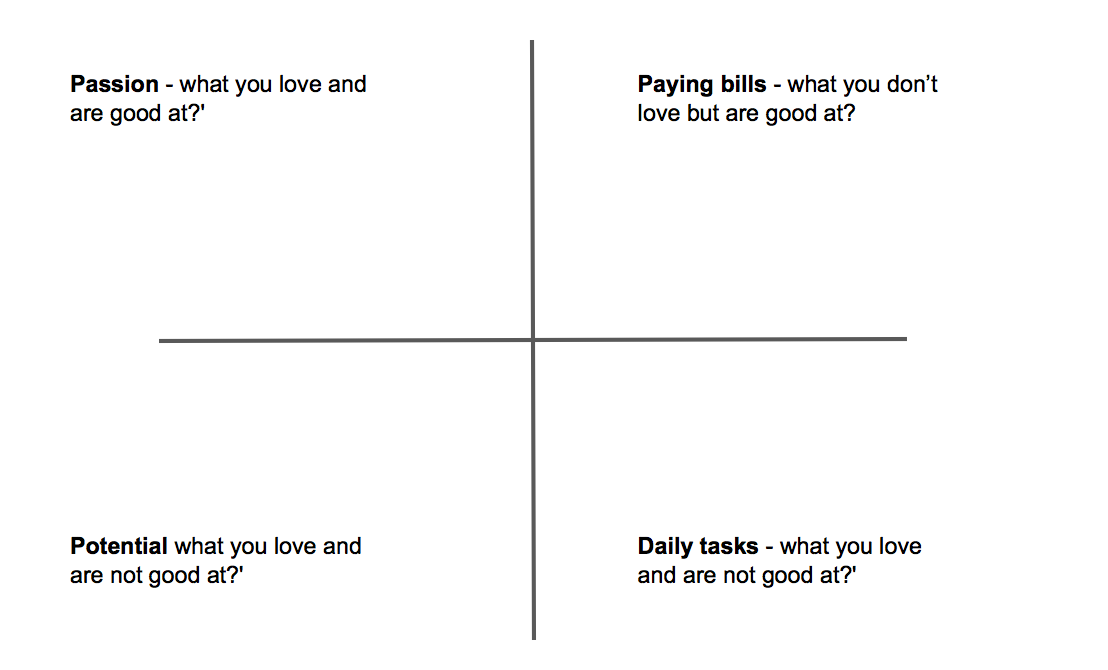
My goal is to arrive at a place where I am still clear about my passion but with an open mind on the mediums through which I can express this in the short and medium-term. A great example of this is Brian Chesky the founder of Airbnb. It’s simple to think of Chesky as a successful tech founder but that would be disingenuous. Chesky is first and foremost a designer with a passion for aesthetics, form and user experience which is arguably the core component of what made AirBnB successful as a disruptive company. Very simply, AirBnB is Chesky’s expression of his raison d’etre - his IKIGAI.
IKIGAI should be a selfish exercise and your end-goal is to instill a vision for yourself in 2020 and the coming decade. There will be changes and adjustments on the road which is okay, the secret is in how you adjust and stay the course over time. Having a string of bad days due to business travel or flu doesn’t mean you throw the baby out with the bathwater you get back on the horse and keep moving.
1. An honest assessment of where you are
Honesty is the first chapter in the book of wisdom - Thomas Jefferson
It’s impossible to understand where you are going unless you stop, do an inventory check and orient your compass towards your desired destination. To aid with this reality there are two tools which I’ve been using to help highlight my path:
- The Wheel of Life Paul Meyer
- PYR by Tim Ferris
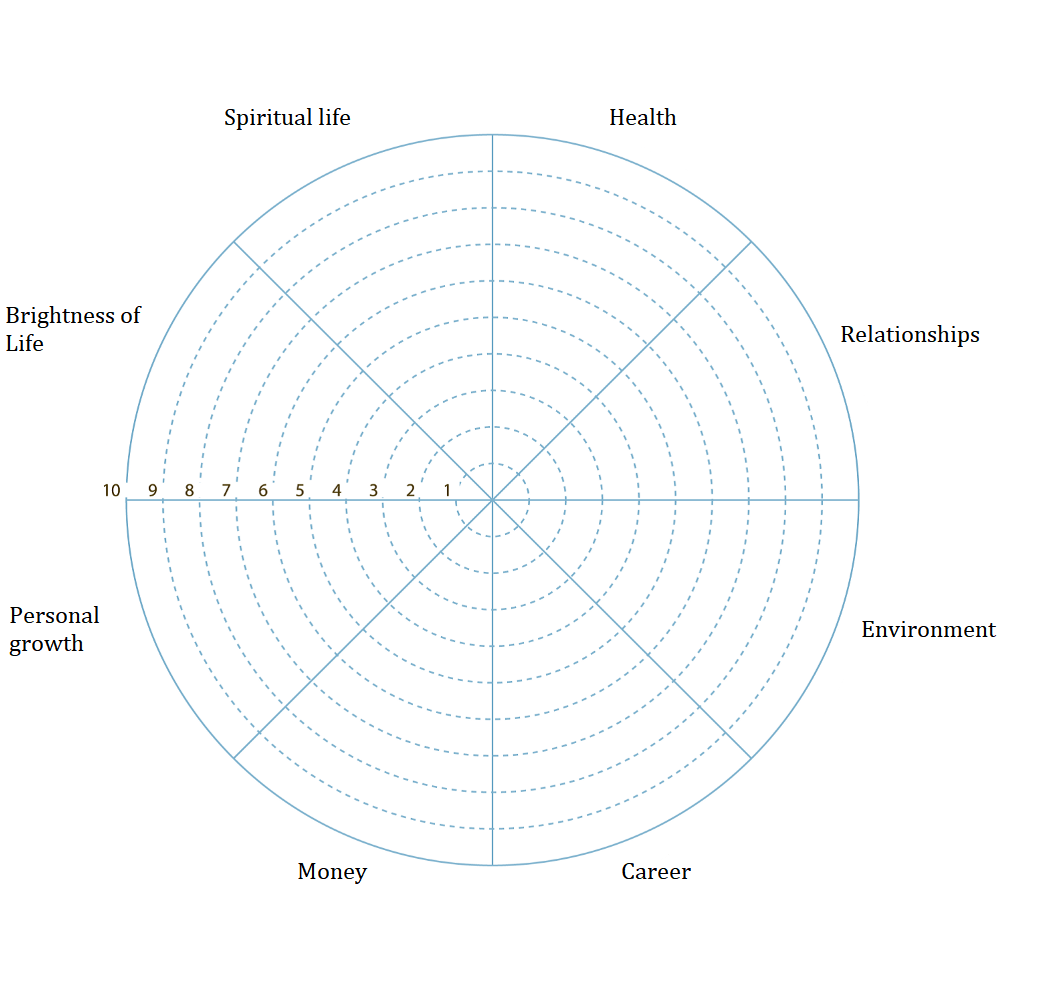
The wheel of life is a popular tool in life coaching created by Paul Meyer that enables you to visualize how you’re performing across key areas of life. Your goal is to honestly assess your historical performance and areas which need increased focus for the coming year. The wheel of life is a template and starting point, you can simply swap out the focus areas should you want to more granularly focus on others but the defaut wheel is usually a great starting point.
The crucial deliverable with this exercise is ensuring that you are honest with yourself about where you are now, don’t hesitate to get the perspective of your partner are a good friend if you’re having some difficulty. Do you feel your personal growth has stalled? Do you feel that your health could be improved? What about your relationships - are you putting forward the best version of yourself? To gain an accurate picture of the challenges these questions pose, you can draw the wheel of life on a whiteboard and map out your position on a scale of 1 - 10 or alternatively score yourself in the exercise sheet I’ve created.
Past behavior is the greatest indicator of future behavior so identifying patterns or drivers of what made you successful, made you fail or contributed to a growth/performance mindset is a crucial insight. As an exercise, it’s invaluable to identify your highs and lows from the previous year.
In the worksheet I’ve contained a timeline to add 2 highs and 2 lows from the previous year. This can be anything from a professional project you shipped successfully in work to a milestone you hit with your side-project, an individual relationship that doesn’t serve you any longer or a relationship where you get a lot of energy. Tim Ferris follows a similar approach in his PYR model and its a super tactic to help identify sources of energy and sources of fatigue so you can optimize your time and calendar around these.
2.What were your learnings from last year?
“Life is a succession of lessons which must be lived to be understood.” ― Ralph Waldo Emerson
Now that you’ve identified where you stand and how the previous year contributed to your growth, your next step is to introspect more deeply on the behaviors and habits that contributed to these outcomes. This is a process of discovery and it changes year over year as you consciously develop other areas. It is important to approach it with an open-mind be honest and shed limiting beliefs and unconscious biases you may have i.e I am introverted or I struggle with attention; if you honestly arrive at to some of these conclusions do so in the context of the activity or project not as a generalist statement. In analyzing my own learnings I have noticed the power of various habits possess a power-law distribution for bringing about positive outcomes in my life so this is a critical part of the process to get correct. In pin-pointing 20% of positive habits, you can bring about 80% positive gains or eliminate the majority of negative outcomes you’ve highlighted.
As an exercise in introspection it is useful to walk yourself through a series of questions which I've outlined in the following sections.
Highs and lows
- What were my top two achievements and what drove them?
- What other goals did I achieve that gave me a sense of accomplishment and pride?
- How has my mindset changed in the last 12 months?
- What new habits have had the biggest impact on my life?
- What new skills did I try to learn and adopt?
- What barriers did I overcome last year and how did I leverage myself and my community?
- What were two key decisions you made last year which you are now grateful for?
- What big bets did you take last year, what did you learn about this?
- Learning from failure
- What were your top two failures from last year and what did you learn?
- What did you learn from the failure of some of your projects?
- What projects did you not complete and what got in the way?
- Where did you spend your time sub-optimally in these projects and why?
Key relationships in your life
- What new relationships were additive to your life? What did you learn about yourself through these people?
- What individual impacted your life the most and how?
- Which relationships do you value most in work and in life, why?
Life learnings
- What are the top two lessons of 2019 you learned?
- What were your top three positive moments of 2019 and why?
- What were your top three negative moments of 2019 and why?
- Describe how 2019 impacted your overall growth in two sentences?
- What are you most grateful for in your life now?
How will you win 2020?
‘A goal without a plan is just a wish’ - Antoine de Saint Exupery.
As you start to close out the reflection and introspection process you will set goals for 2020 to map your course. This final step is about understanding your goals, your motivation, important relationships to help you advance and who you intend to become by the end of the year. At this stage, you will assemble all of the final inputs of your personal vision before you begin to turn the screw and identify SMART objectives and key results for you to keep track of throughout the year.
Objectives and personal growth
- What are your top 4 goals for the new year and why are they important?
- What 3 skills you develop and nurture?
- What one unique character trait will you rely on to reach these goals?
- How do you expect your mindset to evolve over the next 12 months?
- What version of yourself will you become?
Shedding the past*
- What habits no longer serve you and why?
- What should you walk away from?
The power of habits
- What two habits will you stop?
- What new habits will you start?
- What habits will you continue?
Barriers to success
- Are there any fears which will limit your progress and how will you address these?
- What barriers will you face and how can you proactively plan to solve these before they happen?
Key relationships in life
- What relationships need more attention in your life?
- What relationships will you build upon and how?
- How can you pay it forward with a professional relationship and give back?
Next Steps and Planning
“Most people overestimate what they can do in one year and underestimate what they can do in ten years.” - Bill Gates
The reality is that we have a tendency to over-stretch so your next steps involve creating a small set of SMART objectives with KPIs and key results. Your SMART objectives should be tracked in a spreadsheet you review periodically. My SMART objectives for the last few years have revolved around health, wealth, relationships, learning & career. Failure-mode for this exercise is having an unreasonable amount of objectives across too many focus areas from your IKIGAI or wheel of life so I typically stick to 4 areas and this works for me. In my tracker, I attach a brief description of each major focus area on what I am seeking to bring about followed by sub-objectives in each focus area. You can also get started immediately with some of the worksheets I've created.
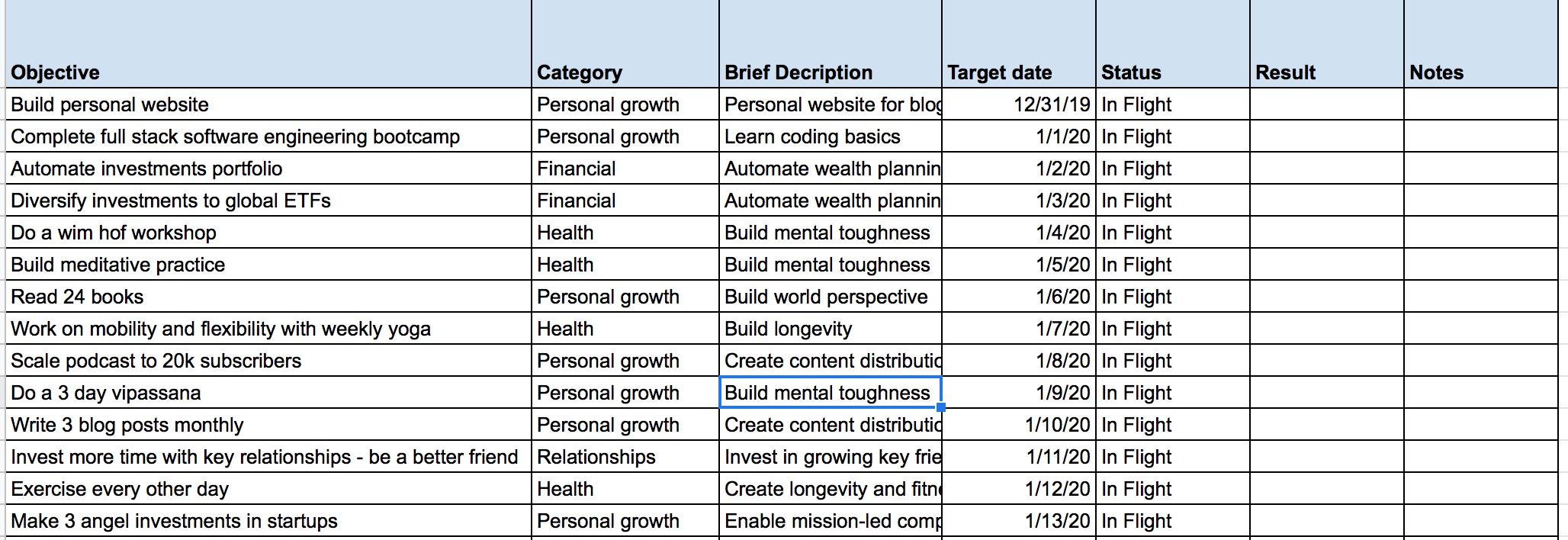
Your sub-objectives should be specific and will be something like :
- Take guided meditation in the afternoons to work towards building a daily habit by EoQ1
- Make 3 angel investments in health technology startups by the end of the year.
- Automate payments to investment portfolio by end of January to invest in passive ETFs.
- Write 3 blog posts monthly on your personal website about management and productivity.
- Complete coding course by end of Q1 and write up a summary blog post on learnings.
To hit the ground running with your new plan you should complete the following steps.
Establish your vision
- Populate your IKIGAI to inform your focus areas and build an IKIGAI vision statement of two short paragraphs for where you expect to be by EoY.
- Populate a forecast for where you expect your wheel of life scores to improve by EoY. Realistically select a few focus areas and aim for 2% - 3% increases by EoY.
Measure and deliver
- Populate SMART goals with target dates for you to review periodically throughout the year.
- Populate a corresponding timeline and deliverables by month
- Add to calendar 3 month review points for you to review and check-in on progress with personal goals
Build and incentivize good habits
- Add to calendar activities, check-in points, and Ulysses contracts to fuel your energy and remain accountable.
- Track key habits in a habit tracking app. I use the Streaks application for mobile where I am tracking power-law habits that will put me in the best position to hit my goals
Lastly I have found that consistency in habits is the key determinant of success with goal setting. There will be hiccups along the road but the answer is being able to adapt and pivot to ensure overall consistency whilst being disciplined enough to carve out time to focus on your goals. Your environment and ability to curate good habits will set you up for productivity on any given day. A good model to follow is James Clear cue, craving response, reward framework to ensure your habits are stacked appropriately leveraging your environment and building systems.
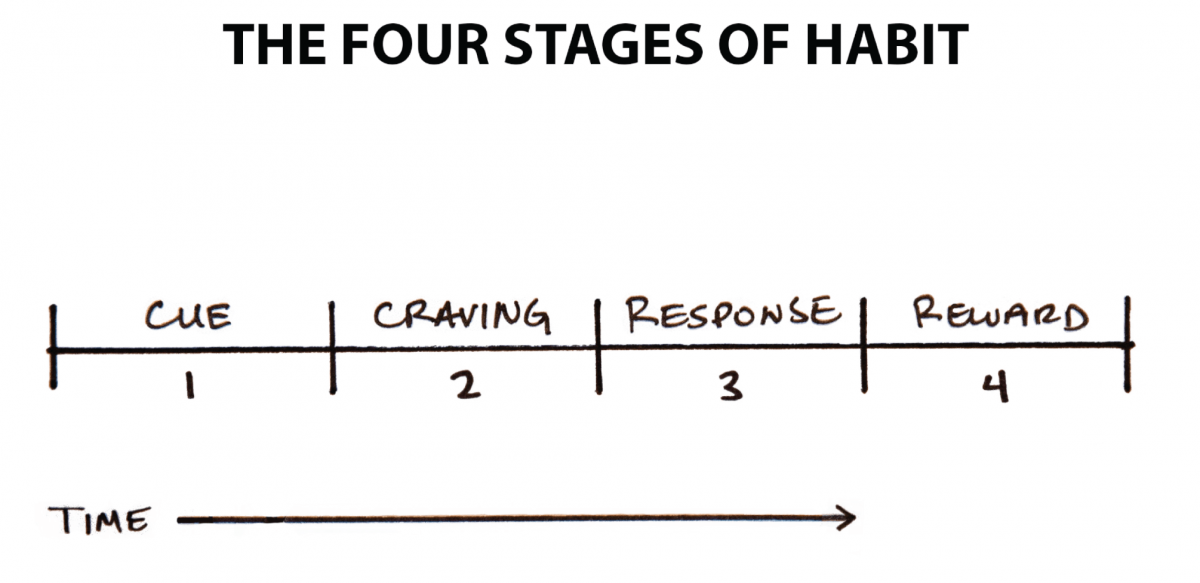
As an example I try to start each day with meditation and red light therapy which almost always sets me on the correct path towards my daily goals. I keep a meditation space and red light unit on my landing to hack my environment for productivity and the day ordinarily flows into journaling and exercising.
If you have any other techniques for life productivity and creating goals I’d love to hear from you! Get me on Twitter on @RossySheil.

